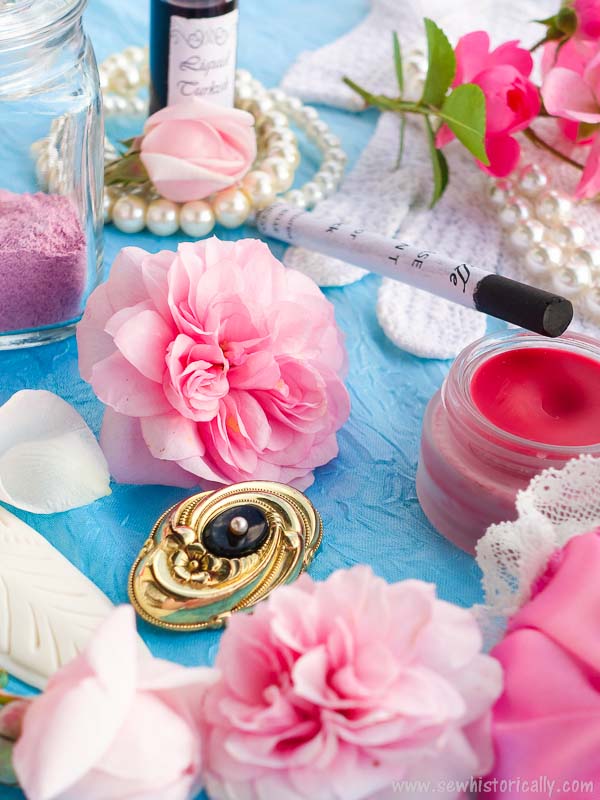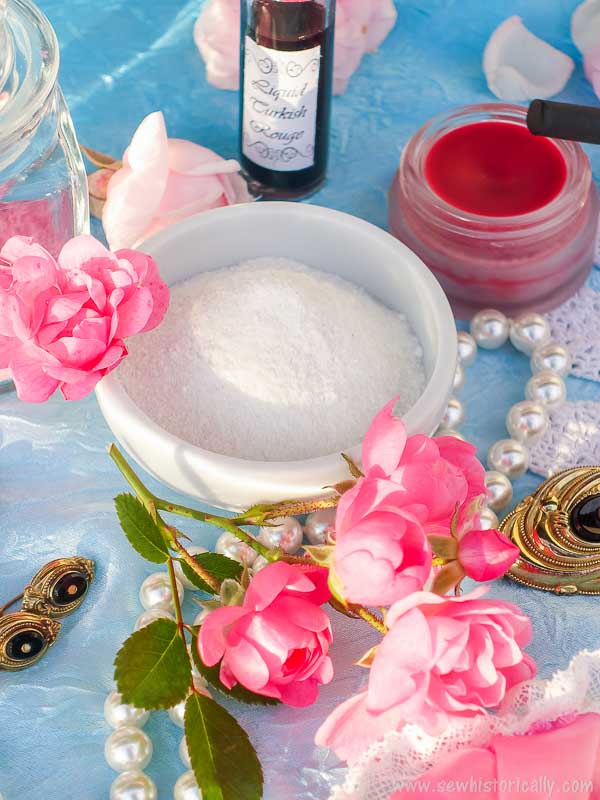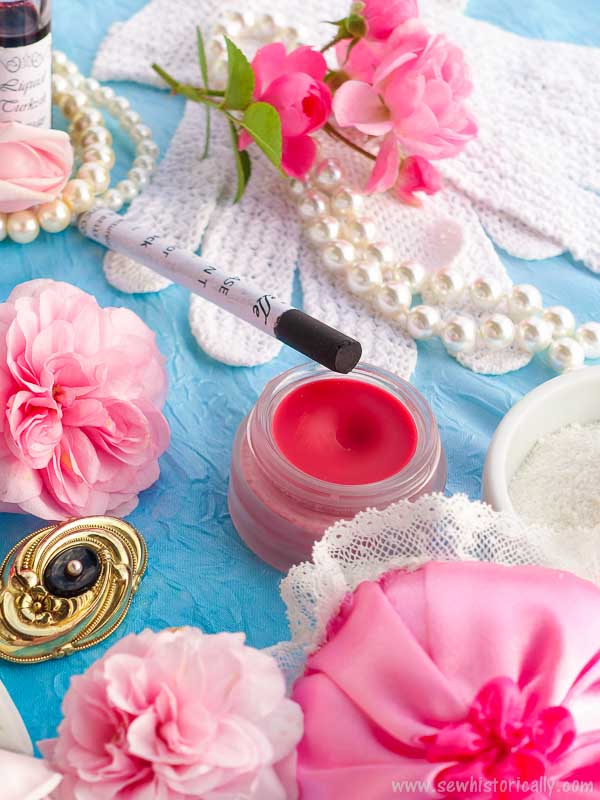In this part of my ‘Victorian And Edwardian Beauty Routine And Recipes’ series, makeup is the topic. I’ve compiled makeup tips from the Victorian era till the 1920s, as well as different Victorian and Edwardian face powder recipes.
‘She sat in front of her mirror, and with rouge, powder and black pencil went deliberately to work to show her face how wrong it was, and succeeded.’ (The Saint Paul Globe, 1902)
How to Apply Makeup (Health And Beauty Hints, 1910)
Before applying powder, rub cold cream or mixture of 1 teaspoon glycerine and 1/2 pint rosewater into the skin. After the face is powdered, rub the skin with an adstringent lotion, such as lettuce water, ‘to remove the dust from the pores’. A way of scenting face powder is ‘to keep a stick of orris root in the jar’.
How to Apply Makeup (Sacramento Union, 1909)
‘Start the cosmetic toilette by washing the face with warm water and a good soap. This rests and softens the skin so that the red and white will blend with it and not lie outside in a solid, unnatural sheet. Then rub in cold cream with brisk, yet gentle massage, and sit to your dressing table to a good twenty minutes of toil, seeing to it that ail the implements of war, as well as a hand glass lie in line before you. The rouge is put on first, the brows and eyelids darkened next, and the powder applied last of all. A soft spun silk, linen or cotton rag is indispensable, for this must smooth down hard edges till the line between the color and natural skin is lost.
To apply the rouge, dig a right-hand finger into the red and rub it over all the points which have ever displayed a hint of natural rosiness. Some faces need a touch of rouge upon the chin and lips, a faint tinting of the eyelids, and a decided rosiness for the lobes and curl of the ear. The lid-tinting is to give the tall of the eye fulness, and the chin, lip, and ear touches make the cheek blush seem more natural. Leave this application to sink into the skin and proceed with the dark cosmetic.
Except for the fairest women, who use a blonde pencil, brun (brown) is the best color for this. Follow the natural eyebrow line with the pencil, and never make a mark, if you can help it, on the bare skin. Then rub the dark pencil across the palm of the left hand, and with a clean finger of the right gather up this soft brown, blonde, or black dust and rub it delicately over all the eye covering. A hard line made by a dark pencil under the eye is very bad, but few persons not in Beauty’s secret will be able to suspect the artificiality of the improving over-shadow made in this way. But the red and the black are only a breath – they must seem the reflection of the ball of the eye through a thin lid.
You now come to the important “make-up” rag, and with one corner of this go over the rouge, and with another over the lids till your own mother could not tell where her daughter begins and art ends. Then dust on the powder, smoothing that with still another corner of the rag.’
Related: Vintage Powder Puff Tutorial
Face Powder (Sacramento Union, 1909)
‘As to powder, the simpler the ones used with rouge the better, as it is really the thick, fast-sticking white which gives the improper and clownish look. Scented talcum, rice, wheat powder and prepared chalk are the only secure powders for a sensitive skin. If you must have something more concealing and fast than these, be sure you match your complexion with the powder tint, blonde, brunette or pink.’
Face Powder (The White House Cook Book, 1899)
- 1/4 pound wheat starch
- 8 drops rose oil
- 30 drops lemon oil
- 15 drops bergamot oil
Sift the starch through a fine sieve or a piece of lace, and add the essential oils.
Violet Poudre De Riz (Henley’s Twentieth Century Formulas, Recipes And Processes, 1916)
- 7 pounds cornstarch
- 1 pound rice flour
- 1 pound powdered talc
- 1 pound orris root
- 3 ounces extract of cassia
- 1 ounce extract of jasmine
Violet Powder (A Perpetual Calendar: With Notes and Explanations on Chronology, Chronological Cycles and Other Useful Information, 1896)
- 6 parts wheat starch
- 2 parts orris root powder
- attar of lemon
- attar of bergamot
- attar of cloves
‘Having reduced the starch to an impalpable powder, mix thoroughly with the orris root and then perfume with attar of lemon, attar of bergamot and attar of cloves, using twice as much of the lemon as either of the other attars.
Violet Powder (The Cyclopædia of Practical Receipts in All the Useful and Domestic Arts, 1841)
‘Good starch in fine powder, and mix it with a little orris-root powder and essence of lemon to give it a slight perfume.’
‘Powders for the hair and skin have almost gone out of use. The basis of perfumed powders is either orris, or fine pearl starch. The perfume of the finest kinds is imparted by alternating layers of starch and fresh flowers, the latter being afterwards separated by sifting.’ As it is tedious and expensive, powders are often scented ‘by the direct addition of extracts or essential oils’. (Encyclopedia Of Practical Receipts And Processes, 1872)
Rose Face Powder (The New Cyclopaedia of Domestic Economy, and Practical Housekeeper, 1871)
- 7 pounds wheat starch
- 1/2 drachm rose pink
- 2 drachms rose oil
- 2 drachms santal oil
Rose Poudre De Riz (Henley’s Twentieth Century Formulas, Recipes And Processes, 1916)
- 9 pounds cornstarch or potato starch
- 1 pound powdered talc
- 1 1/4 drachms rose oil
- 6 drachms jasmine oil
Make-up shouldn’t be worn every day, just on special occasions. Cosmetics of good quality should be used with protecting face cream underneath. (Every Woman’s Encyclopaedia, 1910-2a)
How to tint your Face Powder (Every Woman’s Encyclopaedia, 1910-2b)
For very fair skin, tint white powder pink with carmine; while brunettes should tint their white powder with yellow ochre or orris root; a cream tint is suitable for the average complexion. Instead of a powder-puff, apply the powder with chamois leather, flannel, or cambric.
Powder which by now has replaced white paint can also be used for a smooth complexion. ‘But, however skilfully it is applied for this purpose, its use may be detected in a sidelight, when the skin will have a dull uniformity of tint not to be compared to the tinting of a real complexion, wherein a “peachlike bloom” is obtained by the down on the skin softening the satiny gloss of Nature.’ (Every Woman’s Encyclopaedia, 1910-2b)
Rice Face Powder (Household Companion: Book Of Etiquette, 1909)
‘It is sometimes necessary to powder the face, but powder should be applied lightly and artistically in order to impart to the skin the velvety softness of the peach. Powder on the face should be imperceptible, and, if used with discretion, is not to be condemned.
Take up but a small quantity of powder on the puff, and pass lightly over the face. Care should be taken not to powder the eyebrows, and the lips must be carefully wiped to remove any powder which may have fallen. The whole face, except the eyes, the eyebrows, and lips, should receive a touch of powder.’
‘The woman who goes on the street in the sunlight is considered foolish to use any sort of cosmetics, except a very simple rice powder over liquid rouge.’ (Daily Press, 1910)
A Good Face Powder (Sacramento Union, 1907)
- 50 grains farina starch
- 20 grains powdered talcum
- 20 grains powdered lycopodium
- 20 drops essence of violet
- carmine enough to make a delicate pink
It is better to preserve the complexion through proper eating, exercising, and face cleansing ‘than trying to cover up the defects in your complexion with powder and rouge. When a girl is given a genuine article it seems ridiculous that she should try to cover it up with an imitation. An imitation complexion is obvious and easily detected.’ (A Girl’s Problems In Home Economics, 1926)
Rose Powder (Henley’s Twentieth Century Formulas, Recipes And Processes, 1916)
- 200 parts powdered iris root
- 600 parts rose petals
- 100 parts sandalwood
- 100 parts patchouli
- 3 parts geranium oil
- 2 parts rose oil
‘I should like to say this – that I am convinced that every woman has a beauty of some sort, and she owes it to herself to make the most of it, and ignore those things which are not beautiful. It may be hair, it may be eyes, it may be complexion, it may be any feature or quality which people admire in a woman. It will be there, and if she will only cultivate it simply and without parade, she will always find people who will admire it.’ (Every Woman’s Encyclopaedia, 1910-2c)
Face Powder With Chalk (Heredity, Health And Personal Beauty, 1890)
- 1 ounce prepared chalk
- 1/2 ounce carbonate of magnesia
- 1/2 ounce pulverized chalk
- scent with rose
- optional: for flesh color: 3 grains carmine
‘It is sometimes necessary to powder the face, but powder should be applied lightly and artistically in order to impart to the skin the velvety softness of the peach. A face powdered like a clown’s is ridiculous, and as unbecoming as it is vulgar. Powder on the face should be imperceptible, and if used with discretion is not to be condemned. Take up a small quantity of powder on the puff and pass it lightly over the face. Care should be taken not to powder the eyebrows, and the lips must be carefully wiped to remove any powder which may have fallen. The whole face, except the eyes, the eyebrows and the lips, should receive a touch of powder.’ (The Washington Times, 1909)
Lily Complexion Cream (The Woman’s Own Book of Toilet Secrets, ca. 1896)
- 4 oz cologne spirit (95 %)
- 2 oz precipitated chalk
- 4 oz rose water
- 1/4 oz glycerine
- 2 drachms extract white rose
‘Mix the chalk thoroughly with the cologne spirits, then add the other ingredients and shake well. Directions for use: shake the bottle and apply the cream with a small sponge. When it dries distribute with a soft cloth to suit the taste. Lily Cream makes the complexion fresh and beautiful.’
Grease Paints (Henley’s Twentieth Century Formulas, Recipes And Processes, 1914)
‘Theatrical face paints are sold in sticks, and there are many varieties of color. Yellows are obtained with ocher; browns with burnt umber; and blue is made with ultramarine. These colors should in each case be levigated finely along with their own weight of equal parts of precipitated chalk and oxide of zinc and diluted with the same to the tint required, then made into sticks with mutton suet (or vaseline or paraffine, equal parts) well perfumed. By blending these colors, other tints may thus be obtained.’
Complexion Pomatum (A Perpetual Calendar: With Notes and Explanations on Chronology, Chronological Cycles and Other Useful Information, 1896)
- 1 pound mutton grease
- 4 oz oxide of bismuth
- 2 oz powdered French chalk
‘Mix.’
Here you’ll find my Conversion Table for US, UK, and metric system units of measurement.




This was such a feminine post I really enjoyed reading it and looking at your lovely photos. Thanks for sharing with us at #BloggersPitStop. Have a lovely day.
Thanks for your lovely comment, Sue!
A marvelous post with lots of historical information. I’m a big history nut and loved learning about Victorian make-up. Thanks for sharing at #TrafficJamWeekend
Thank you, Evelyn!
I wonder how these old recipes compare to modern day make-up? I don’t wear make-up but would be interested to try these to see how they look, feel and smell. #WasteLessWednesday
The rice face powder and violet face powder are better than the store-bought face powders I tried. It matches my skin tone better, it gives the same coverage without the cakey feeling and it keeps the skin shine-free longer.
What an interesting post! I find it interesting the way the old articles you found read. I just read through a book of the same time period last week about how to treat ailments that read the same way. Thanks for a really neat post on the #wearepinnable party
Thanks for stopping by, Allie!
I can just imagine young women learning how to make these. I always enjoy reading your posts. I find them femininely fascinating.
Thanks for your lovely comment, Leanna! 🙂 A proper Victorian or Edwardian lady had to make her own makeup because it still wasn’t acceptable in the Edwardian era to buy makeup. 😉 It was also considered improper to talk about makeup or apply face powder in public.
Wow it is wonderful to read all these makeup recipes from the past
Thank you, Amber!